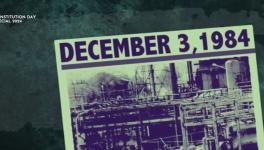An Exercise in Futility: Speculative Research on Impact of Bhopal Disaster

The study by McCord et al., entitled “Long-term health and human capital effects of in utero exposure to an industrial disaster: a spatial difference-in-differences analysis of the Bhopal gas tragedy” (BMJ, June 13,2023) is reportedly an attempt to provide further insights into the long-term impact of the Bhopal gas leak disaster of December 2-3,1984 on human beings. The study begins by reiterating that: “Evidence from India suggests high numbers of industrial accidents, with the highest associated attributable deaths in the world.”(p.1) It has also correctly pointed out that “…little research is available on…multigenerational impacts, and inadequate recognition of these far-reaching repercussions can diminish the memory of such tragedies for policy consideration.” (pp.1-2) Therefore, the authors claim that: “This research provides insight into these impacts on children born to female survivors of one of the worst industrial disasters in history, the Bhopal gas disaster (BGD).”(p.2)
The main findings of the study were purportedly as follows: (a) “Women who lived within 100 km of Bhopal experienced a relative decrease in the birth of males in the 1985 cohort (64% of children born from 1981 to 1984 were male, a proportion that drops to 60% in 1985)”: and (b) “As in the case of differences in sex ratios, the abnormally high cancer rates appear to extend up to 100 km from Bhopal.” (p.4)
Wrong Assumptions
At the very outset, it may be noted that some of the assumptions with which the study has proceeded are erroneous. For example, the claim that: “The leak spread toxic gas in approximately a 7 km radius around the plant” (p.2) (emphasis added) is an unsubstantiated claim. None of the references provided by the authors in this regard support such an assertion. The toxic plume actually spread to approximately 40 sq km of area outside the pesticide plant due to the breeze that was then blowing in the southeast direction with a velocity of approximately 10-11 km/hr.[1]
The claim that the escaping “MIC toxins affected groundwater” (p.2) is also incorrect. As a matter of fact, groundwater was contaminated due to dumping of toxic waste from the plant – both in pits within the plant as well as in the ‘Solar Evaporation Pond’ (SEP) that was dug adjacent to the plant – while the plant was in operation from 1969 to 1984, i.e., prior to the disaster. Of course, the escaping MIC related toxins did contaminate the Lower Lake and a part of the Upper Lake of Bhopal, which adversely affected aquatic life – at least for a brief period. Unfortunately, the results of numerous studies carried out by State-run institutions like the Indian Institute of Toxicology Research (IITR), Lucknow; Indian Veterinary Research Institute (IVRI), Izatnagar (UP); Veterinary College, Mhow (MP); etc., in this regard have not been made public till date.
Findings Still under Wraps
Findings from several of the Bhopal disaster-related research carried out by institutions like the Defence Research Development Establishment (DRDE), Gwalior; Defence Institute of Physiology & Allied Sciences (DIPAS), Delhi; Institute of Nuclear Medicine & Allied Sciences (INMAS), Delhi; Indian Institute of Chemical Technology (IICT), Hyderabad; National Chemical Laboratory, Pune, etc., are also still under wraps.
Moreover, results of the numerous studies carried out by the Indian Council of Medical Research (ICMR) during 1984-1992 were officially published only 15 to 21 years later, i.e., between 2007 and 2013. From 1994 to 2010, ICMR did not undertake any Bhopal disaster-related medical research. However, due to pressure from victim groups, the ICMR was forced to restart Bhopal disaster-related medical research by establishing the National Institute for Research in Environmental Health (NIREH) in Bhopal in 2010.
NIREH has reportedly conducted a few Bhopal disaster-related studies between 2010 and 2018, the results of which are not yet in the public domain.[2] Since 2018, the only ongoing study related to the Bhopal disaster at NIREH is the ‘Long-Term Epidemiological Survey on Health Effects of Bhopal Toxic Gas Exposure’, which in January 1985 had identified a cohort of about 80,000 in the gas-exposed areas and a cohort of about 16,000 in the purportedly non-exposed areas of Bhopal for carrying out the survey.
Unfortunately, by the time the survey actually began in 1986, the size of the cohorts had come down to about 60,000 in the gas-exposed areas and to about 13,000 in the non-exposed areas. During 1994-2010, when the ICMR had remained practically indifferent to the cause of the Bhopal gas victims, the said survey was kept alive by a team of dedicated doctors under the aegis of the Centre for Rehabilitation Studies (CRS), which was established by the government of Madhya Pradesh with very modest funding from ICMR.
Due to lack of adequate resources and necessary support, the survey team was unable to keep track of the entire cohorts. As a result, by 2010 the size of the cohort drastically came down [see: p.13] to less than 17,000 in the gas-exposed areas and to less than 6,000 in the so-called control areas. By 2023, the size of the cohort has further reduced to just about 10,000 in the gas-exposed areas –COVID-19 providing the additional reason.
No data is available on the fate of the 70,000 gas victims from the original cohort from the gas-exposed areas, who have literally disappeared from the scene. However, even available findings show that morbidity rates in the gas-exposed areas [see pp.87-90] have been consistently high.
Therefore, the said report prepared by CRS & NIREH in 2013 could not but record as follows:
“…it is recommended that newer studies on remaining population of original total gas exposed population of 5,74,000 may be undertaken and extensive follow-up with major focus on clinical disease identification and treatment. The studies should be planned in such a manner so that they can impact guidelines for health service sector to implement treatment measures.” [p.34]
Unfortunately, medical surveillance of the gas-exposed population is still proceeding in a haphazard manner and at an extremely slow pace. It is extremely disheartening to note that during the last 39 years just about 15% of the medical records of individual gas victims have been digitalised and networked so far. The review of the study by McCord et al (2023) is being carried out in this background.
The Problem
It is true that over half a million [official figure of dead and injured is 572,697, see: Para 17, Column G – excluding rows 6 & 7] of the then 900,000+ residents of Bhopal became victims of the disaster and well over 30,000 of them may have perished over the years due to the adverse effects of the toxic fumes. However, according to the figures submitted by the Government of India before the Supreme Court of India, only 5,479 gas victims died and 527,727 others suffered just “minor” injuries (see: Para 17, Column G – rows 1 & 5).[3]
Nevertheless, the McCord et al. (2023) study under review has noted that:
“There is a broad spectrum of serious long-term and chronic health consequences for hundreds of thousands of survivors, including children, manifesting across multiple systems (eg, respiratory, neurological, musculoskeletal, ophthalmic, endocrine)”. (p.2)
Furthermore, according to the study:
“Potential in utero effects cannot be understated. Studies document a fourfold increase in the rate of miscarriage following the gas leak, as well as increased risk of stillbirth and neonatal mortality. Decades after the disaster, menstrual abnormalities and premature menopause have emerged as common problems among exposed women and their female offspring. MIC has also been shown to damage human chromosomes. Early clinical studies on the gas-affected population showed signs of increased chromosomal aberrations that could manifest as cancer…” (p.2)
Thus, the stated objective of the study was as follows:
“This paper estimates the long-term health (specifically, adult cancer rates and disability) and human capital impacts (educational attainment) on individuals who were exposed to the BGD in utero or as children in 1984.” (p.2)
So far so good!
Questionable Methodology
However, the methodology chosen for conducting the study is highly questionable. While there may be nothing wrong in principle for relying on data generated by the National Family Health Survey (NFHS) or by the National Sample Survey Organization (NSSO), the decision, as stated in the study, to extend the area of coverage of the study for a distance of 250 kms away from Bhopal is totally incomprehensible:
“For the first analysis focusing on differences in the sex ratio, the analytical sample includes children born between 1981 and 1985 to women who were interviewed in Madhya Pradesh and who lived within 250 km of Bhopal (n=1260 births).”(p.2)
What was the rationale for assuming that the impact of the Bhopal disaster may have spread up to a radius of 250 km from Bhopal? It is evident that the said assumption is based on nothing but unwarranted speculation. The inferences from the study are even more startling:
“Given the two spatial patterns in figures 3* and 4**,we use 100 km as the BGD exposure cut-off in our analysis.” (p.5) [Emphasis added]
*In the said study, Figure 3 is interpreted as follows:
“Women who lived within 100 km of Bhopal experienced a relative decrease in the birth of males in the 1985 cohort (64% of children born from 1981 to 1984were male, a proportion that drops to 60% in 1985). This is consistent with male fetuses more affected by external stress.” (p.4)
**Figure 4 is interpreted as follows:
“Similar to patterns seen with changes in the sex ratio, children who were born in 1985 (the year following the BGD) and who lived close to Bhopal during the disaster experience much higher rates of cancer as adults compared with adults who were born before or after the disaster and who lived further away from Bhopal…. As in the case of differences in sex ratios, the abnormally high cancer rates appear to extend up to 100 km from Bhopal.” (p.5)
Erroneous Interpretations
By asserting that “we use 100 km as the BGD exposure cut-off in our analysis”, the authors are trying to establish that the actual impact of the Bhopal disaster was not confined to 40 sq km of area – as assessed by ICMR in 1984, but that its impact had, in fact, spread to no less than 31,416 sq km (an area with 100 km as the radius from the pesticide plant – as claimed in Figure 1 [p.3]), which is nothing but an untenable claim. The authors’ assertion that the area of impact of the Bhopal disaster was 785 times greater than what was assumed previously is based entirely on Figures 3 & 4 – with the causative factor being pinned on the Bhopal disaster, which is highly questionable.
As far as Figure 3 (in the report) is concerned, the reported 4% drop in male births in the 1985 cohort can hardly be considered alarming. Even if the said drop of 4% is assumed to have significance, how does it in anyway prove that the said 4% drop was due to the impact of the Bhopal disaster when there is not an iota of corroborative evidence to substantiate the claim that the toxic fumes or residues had in fact traversed up to 100 km away from the Union Carbide pesticide plant?
The reality is that there was actually an improvement in 1985 in the sex ratio from 64:36 to 60:40 in favour of females, which the authors have tried to interpret negatively. The authors have chosen to rule out the possibility that this development could have been due to reduction in female feticide, which was otherwise rampant. Suppose the sex ratio had further declined to 68:32, would the authors have chosen to interpret the change as a positive development? Moreover, there is no conclusive proof that male foetuses were more adversely affected by external stress. In fact, one of the latest studies on the subject titled “Sexually Dimorphic Accumulation of Persistent Organic Pollutants in Fetuses” (2022) had concluded as follows:
“Prenatal exposure to POPs has been associated with adverse health outcomes, though sex-specific effects are sparse and inconsistent.” [4]
Therefore, it is very unfortunate that the authors have sought to draw far-fetched conclusions on the basis of the NFHS data.
Similarly, as far as Figure 4 is concerned, the findings about cancer cases across 100 km are admittedly based on “Self- reported cancer incidence among men and women living in Madhya Pradesh in 2015, by distance to Union Carbide plant”. (p.5) According to the primary author of the original paper titled “In Utero Exposure to Industrial Disasters: A Case Study of the Bhopal Gas Tragedy” (2022) [the present study being a revised version of the same] “Cancer was assessed as a general question ‘Do you currently have cancer…’” [5] How does an individual – whether literate or illiterate – on his/her own determine that he/she is suffering from cancer? No, it is just not possible to make such self-assessment, especially regarding cancer.
Anyway, no information has been provided on whether the self-reporting was substantiated with documentation. In the absence of such documentation, on what basis do the authors jump to the conclusion that since some respondents are making such claims, those respondents not only have cancer but also that the causative factor in such cases is exposure to toxic substances from the Bhopal disaster?
The authors have not found it necessary to provide any tangible proof that the toxic substances from the Bhopal disaster had actually traversed up to 100 km in all four directions from the pesticide plant and that exposure to such toxic substances could have triggered off those cancer cases. The authors have also not clarified whether the reported cancer cases are from those who were in utero or present in the gas-exposed areas of Bhopal at the time of the disaster but have since resettled far away from Bhopal.
Dissipation of Toxicity
According to available information, one of the storage tanks at the Union Carbide pesticide plant that contained about 40 tonnes of methyl-isocyanate (MIC) – an extremely toxic chemical – got contaminated with water and other impurities, which resulted in exothermic reactions within the tank leading to generation of toxic gases that escaped into the atmosphere through the Vent Gas Scrubber (VGS) and the Flare Tower, both of which were dysfunctional at that time.
Simultaneously, the rising temperature and pressure within the tank led to pyrolytic decomposition of MIC into Hydrogen Cyanide (HCN), Carbon Monoxide (CO), Ammonia (NH3), etc., almost all of which were as toxic as MIC. Ultimately, the safety valve gave way and almost the entire toxic concoction (MIC+ its pyrolytic derivatives) burst into the atmosphere directly from the tank. It took about two hours before pressure in the tank decreased and the safety valve reset itself.
The manner in which the spewing toxic concoction had affected the exposed population has been described by the ICMR as follows:
“Based on the prevailing meteorological conditions it was observed that strong inversion currents prevailed at that time of the night slowly drifted the toxic cloud, affecting both human and plant life along its path over an area of approximately 40 sq km. Since it was a comparatively cold and humid night the toxic gas cloud behaved like an ‘aerosol’, settling on the adjoining area in the shape of a mushroom, engulfing the population and then gradually spreading to the neighbouring areas. A large proportion of the exposed population inhaled this ‘aerosol’ and instantly developed acute respiratory symptoms; also contact with eyes produced acute severe eye problems. In utter panic, they ran helter-skelter, seeking protection and relief.”(p.1)
As per available evidence, the toxicity of the said concoction (MIC and its pyrolytic derivatives) had almost completely dissipated within a few hours of their escape with the toxic cloud concurrently moving to a distance of about 7-8 km from the pesticide plant. Once the said chemicals or chemical compounds mixed with cold air and moisture, they got diluted to non-toxic concentrations since the toxicity of those chemicals or chemical compounds fell below their Threshold Level Value (TLV) and those chemicals or chemical compounds no longer remained potent or dangerous. Also, at low temperature and pressure, MIC reacts with moisture to form Methylamine (MMA) and Carbon Dioxide (CO2), which are relatively far less toxic.
To what distances any remaining residues with carcinogenic potential may have spread and caused havoc remain unknown. This is an area that requires further investigations. Of course, if radioactive chemicals were involved, radioactive particles would have spread to a far wider area and caused greater harm due to its inherent properties and long-lasting toxicity.
Alternative Method
There is no doubt that in all likelihood the chances of those in utero and those who were present in the gas-exposed areas at the time of the disaster developing cancer are very high. Whether or not such victims would have developed cancer was an issue that could have been easily resolved through straightforward methods.
Instead of stretching its investigations to a distance of 250 km away from the pesticide plant, the said study should have confined its investigations to a far less geographical area. It should have carried out more intensive investigations primarily within the 40 sq km of known gas-exposed areas of Bhopal to establish and corroborate that fact.
There was also a pressing need to scrutinise the status of various other health-related issues still confronting the gas victims even nearly four decades after the disaster. For comparative purposes, investigations could have been extended by another 10/15 km or so to the edge of Bhopal city, which would have generated valuable data since there was a sizable population residing beyond the known gas-exposed areas and the outer limits of the city even at the time of the disaster.
On the contrary, the area between the edge of Bhopal city and the next 80 km or so is sparsely populated with just two or three small towns and a few villages interspersed with vast stretches of empty spaces. Therefore, the purported attempt to study the impact of the Bhopal disaster far beyond Bhopal through complicated methods even before fully understanding what might have transpired within Bhopal appears extremely strange.
There is no doubt that there is a crying need for conducting proper and well-designed studies to understand the magnitude, gravity and consequences of the impact of the Bhopal disaster on living beings and the environment, on the one hand, and to explore remedial measures, on the other. The initiative taken by the authors in this regard nearly 40 years after the disaster is, of course, to be appreciated, but if the authors had confined their investigations to the already known gas-affected areas plus another 10 to 15 km distance to the edge of Bhopal City in the then known windward direction in a more intensive manner, the study could have generated valuable information.
N.D.Jayaprakash ([email protected]) is Joint Secretary, Delhi Science Forum & Co-Convener, Bhopal Gas Peedith Sangharsh Sahayog Samiti.
REFERENCES
[1]Map of dispersion of gases, see: M.P.Singh & S.Ghosh, “Bhopal gas tragedy: Model simulation of the dispersion scenario”, Journal of Hazardous Materials, Vol.17, Issue 1, December 1987, p.16 at:
[2]Results of some of the studies – for example, a study on congenial deformation – have been suppressed, see: Minutes of 4th SAC meeting of NIRHE.pdf (bhopal.net); in other instances, several studies – such as the one on Chronic Kidney Disorder (CKD) – have actually been terminated midway.
[3]For a more detailed assessment of the health status of the gas victims see: N.D.Jayaprakash & C.Sathyamala, Victims of Apathy, Medico Friends Circle Bulletin, 361-362, Mar-Dec, 2014, pp.1-7 at: https://www.mfcindia.org/mfcpdfs/MFC361-362.pdf
[4]Richelle D. Björvang & Linn Salto Mamsen, “Sexually Dimorphic Accumulation of Persistent Organic Pollutants in Fetuses”, Frontiers in Toxicology, Switzerland, Vol.4, May 2022
https://www.frontiersin.org/articles/10.3389/ftox.2022.909307/full (last para)
[5] See: Arushi Kaushik, “Essays in Development Economics”, University of California San Diego, 2022, Chapter 2, p.53, at: https://escholarship.org/content/qt5rc2t4p3/qt5rc2t4p3.pdf
Get the latest reports & analysis with people's perspective on Protests, movements & deep analytical videos, discussions of the current affairs in your Telegram app. Subscribe to NewsClick's Telegram channel & get Real-Time updates on stories, as they get published on our website.
























